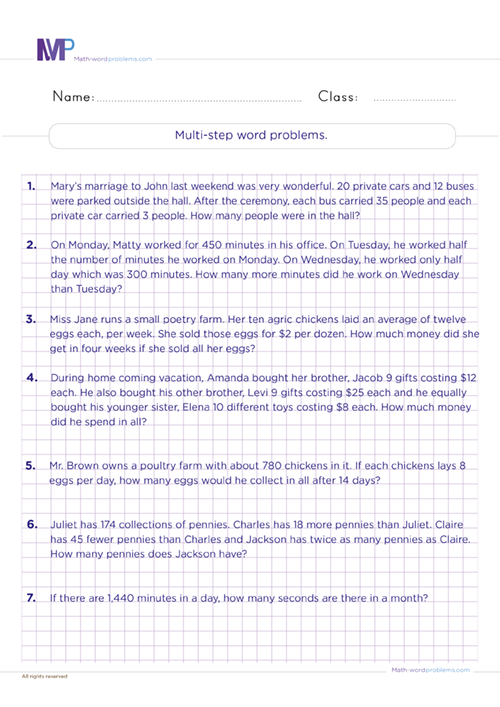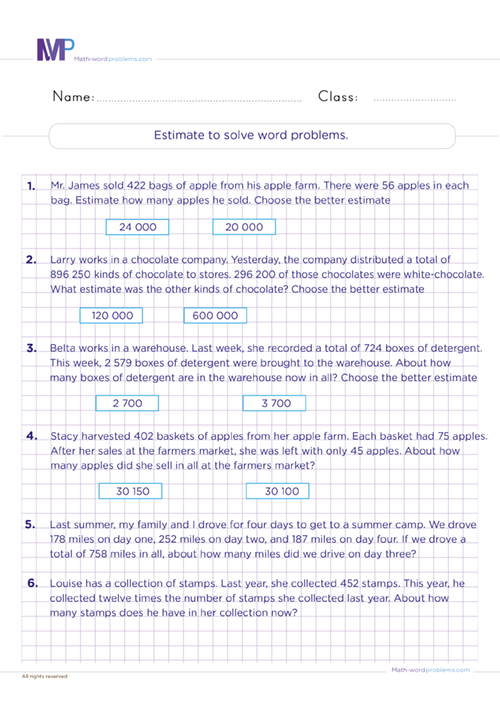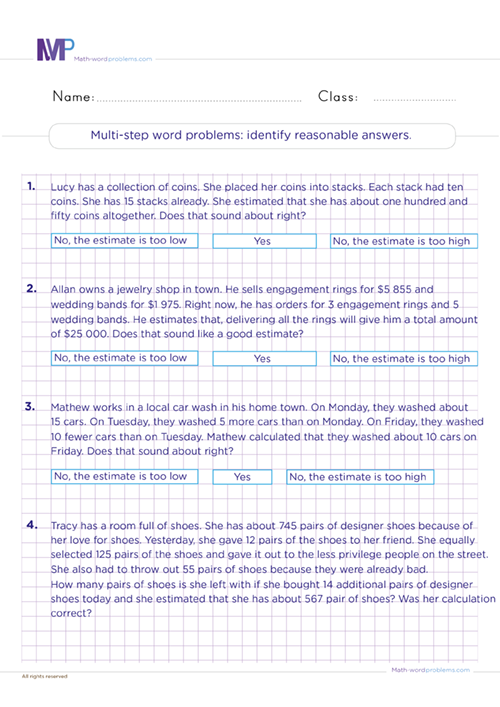 How do you solve multi-step word problems?
How do you solve multi-step word problems?
How do you solve multi-step word problems? Many fun approaches and simple guides here will reinforce the development of 6th graders' multi-step word problem-solving competence.
With our fun designs, we will analyze the complex relationship between traditional math word problems and simple mathematical real-life modeling tasks.
In this guide, kids will most notably discover unique strategies requiring higher-order thinking that will uplift their problem-solving skills. Hence, they will become great math word problem solvers.
It is equally interesting to note that this resource will reinforce kids' reading and computational skills, as they are mostly required when solving multi-step word problems.
As we know, multi-step word problems are usually challenging for most kids. As a result, we will provide a precise plan of how kids can relate math word problems to directly transform the mental representation of these problems into an appropriate, accurate, and solvable math equation.
Simple steps to solve multi-step word problems
The purpose of these simple steps to solve multi-step word problems is to explain how semantic characteristics of mathematical word problems relate to the problem-solving performance of sixth graders.
In order words, these steps will improve kids' performance in solving complex word problems. I.e., they will gain fantastic reading comprehension and mathematical skills necessary to tackle any challenging word problem.
However, following our interesting examples below, you will discover how these steps work.
Step 1: IDENTIFY
Before you identify the problem, you need to read the problem very well and try to understand what the problem is actually saying. While doing so, figure out the important numbers and keywords in the word problem.
Also, when dealing with multi-step word problems, you will find more than one operation in a given question. Below are some keywords on the most important four operations in mathematics.
- Firstly, some addition keywords are namely: - add, plus, more, total, increase, together, Altogether, combined, sum, grow, join, both, in all, and, how many in all, how much, spend in all, etc.
- Secondly, we have some subtraction keywords, which are: - less, minus, take away, left, decrease, difference, fewer, deduct, remain, change, how many more, leftover, less than, how much longer/shorter, how much more, fewer than, discount, etc.
- Thirdly, these are some of the common multiplication keywords that you will come across: - times, multiplied by, product, product of, factor, of, multiply, times, multiple, double, triple, groups, by, twice, area, equal groups, every, in all, total, increased by, as much, each, lots of, groups of, per, etc.
- Finally, here are the most common division Keywords that you'll likely see in a word problem: - divide, half, evenly, every, per, parts, out of, quotient of, ratio of, how many in each, equal parts, cut up, average, as much, etc.
Note: One key Element for learners to understand is that they should not always rely on keywords alone. That is to say; the same keyword can have different meanings in different word problems.
For this reason, we reiterate on the importance of reading the question very carefully to understand the situation that the word problem is describing, then figure out exactly which operation to use
Step 2: STRATEGIZE
How will you solve or tackle the word problem?
- From the keyword(s) in the word problem, you will determine if you need to perform one, two, three, or all of the mathematical operations mentioned above in a single question.
- Besides, it would be best not to count totally on keywords. Instead, try to understand the situation that the problem describes very well before diving into solving it.
- After identifying the keywords, and the operations you are supposed to perform, Construct short expressions/sentences to represent the given word problem.
Step 3: SET UP
At this point, you are expected to write down a numerical expression(s) representing the information in the word problem.
Step 4: PROVIDE A SOLUTION
From Step 3 above, perform one, two, three, or all of the mathematical operations in the word problem. Always add the unit of measurement to your final answer, if any.
Step 5: CHECK YOUR WORK
Lastly, ask yourself this question. Does my answer make sense? If "YES," you are done. If "NO," go back to step 1 and start all over again.
Here is an example on how to solve multi-step word problems for grade six
Step 1: To begin with, after reading the problem very carefully, you see that the important numbers here are 174, 18, 45, etc. Also, the keywords found in the word problem are "more," "fewer," and "twice" combined.
Step 2: Now, how will you solve the problem? Since this is a multi-step word problem, let's interpret each keyword accordingly.
- Firstly, Charles has 18 "more" pennies than Juliet calls for an Addition operation.
- Secondly, Claire has 45 "fewer" pennies than Charles calls for a Subtraction operation.
- Thirdly, Jackson has twice as many pennies as Clair calls for a Multiplication operation.
- Lastly, how many pennies do they have combined calls for another Addition operation?
Next, after identifying the keywords and the operations you are supposed to perform, construct short expressions/sentences to represent the given word problem.
- Number of pennies Juliet has = 174
- Number of pennies Charles has than Juliet = 18 more pennies than Juliet.
- Number of pennies Clair has than Charles = 45 fewer pennies than Charles.
- Number of pennies Jackson has = twice as many pennies as Claire.
- Therefore, the Number of pennies they have in all = the Number of pennies Charles has, than Juliet + the Number of pennies Clair has, than Charles + the Number of pennies Jackson has.
Step 3: Then, write down numerical expressions for each bolded sentence in step 2 to solve this word problem:
→ 174 + 18 = ?
→ 192 – 45 = ?
→ 147 × 2 = ?
→ (174 + 18) + (192 – 45) + (147 × 2) =? → here, you have to use the answer of each equation above.
Step 4: You see that, from step 3 above, you need to perform three mathematical operations in this problem, i.e., Addition, Subtraction, and Multiplication. Now, go ahead and solve the numerical expressions using these operations. Also, remember to add the unit of measurement to your final answer, if any.
(174 + 18) + (192 – 45) + (147 × 2) = 192 + 147 + 294 = ?
So, they all have 633 pennies.
Step 5: Finally, check out your work to know if your answer makes sense i.e., by estimating the numbers and calculating mentally. If the answer is so close to the one you have, then your answer is correct but if the answer is not close to your answer, go back to step 1.






